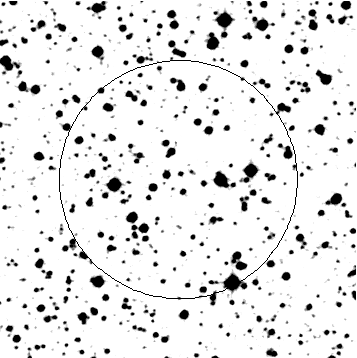- GCN/BACODINE POSITION NOTICE
TITLE: GCN/INTEGRAL NOTICE
NOTICE_DATE: Tue 23 Mar 04 13:03:28 UT
NOTICE_TYPE: INTEGRAL Wakeup
TRIGGER_NUM: 1690, Sub_Num: 0
GRB_RA: 208.4681d {+13h 53m 52s} (J2000),
208.5368d {+13h 54m 09s} (current),
207.6588d {+13h 50m 38s} (1950)
GRB_DEC: -52.3134d {-52d 18' 47"} (J2000),
-52.3341d {-52d 20' 02"} (current),
-52.0678d {-52d 04' 03"} (1950)
GRB_ERROR: 2.80 [arcmin, radius, statistical only]
GRB_INTEN: 13.41 [sigma]
GRB_TIME: 46987.68 SOD {13:03:07.68} UT
GRB_DATE: 13087 TJD; 83 DOY; 04/03/23
SC_RA: 199.91 [deg] (J2000)
SC_DEC: -62.99 [deg] (J2000)
SUN_POSTN: 2.97d {+00h 11m 54s} +1.29d {+01d 17' 18"}
SUN_DIST: 124.67 [deg]
MOON_POSTN: 31.50d {+02h 06m 00s} +12.10d {+12d 05' 53"}
MOON_DIST: 139.69 [deg]
GAL_COORDS: 312.53, 9.39 [deg] galactic lon,lat of the burst
ECL_COORDS: 227.29,-37.60 [deg] ecliptic lon,lat of the burst
COMMENTS: INTEGRAL GRB Coordinates.
- GCN notice #2551
S. Mereghetti, D.Gotz (IASF-Milano), M. Beck, J. Borkowski on behalf of
the IBAS Localization Team, S. Shaw and N. Mowlavi on behalf of the
INTEGRAL Science Data Centre and the INTEGRAL Science Working Team report:
A 20 s long GRB has been detected with the INTEGRAL Burst Alert System
(IBAS) on March 23 at 13:02:59 UT. The GRB has been detected with
IBIS/ISGRI in the 15-300 keV band. The refined coordinates (J2000) are:
R.A. 13h 53m 52.7s
Dec. -52deg 21' 10''
with an uncertainty of 2 arcmin.
The preliminary peak flux in the 20-200 keV range is about 1.7
photons/cmsq/s (2.2 x 10^-7 erg/cmsq/s) (1 s integration time).
This message can be cited.
- GCN/BACODINE POSITION NOTICE
TITLE: GCN/INTEGRAL NOTICE
NOTICE_DATE: Tue 23 Mar 04 14:23:33 UT
NOTICE_TYPE: INTEGRAL Offline
TRIGGER_NUM: 1690, Sub_Num: 1
GRB_RA: 208.4695d {+13h 53m 53s} (J2000),
208.5382d {+13h 54m 09s} (current),
207.6600d {+13h 50m 38s} (1950)
GRB_DEC: -52.3527d {-52d 21' 09"} (J2000),
-52.3734d {-52d 22' 23"} (current),
-52.1071d {-52d 06' 24"} (1950)
GRB_ERROR: 2.00 [arcmin, radius, statistical only]
GRB_INTEN: 13.41 [sigma]
GRB_TIME: 46987.68 SOD {13:03:07.68} UT
GRB_DATE: 13087 TJD; 83 DOY; 04/03/23
SC_RA: 199.91 [deg] (J2000)
SC_DEC: -62.99 [deg] (J2000)
SUN_POSTN: 2.97d {+00h 11m 54s} +1.29d {+01d 17' 18"}
SUN_DIST: 124.64 [deg]
MOON_POSTN: 31.50d {+02h 06m 00s} +12.10d {+12d 05' 53"}
MOON_DIST: 139.65 [deg]
GAL_COORDS: 312.52, 9.35 [deg] galactic lon,lat of the burst
ECL_COORDS: 227.31,-37.64 [deg] ecliptic lon,lat of the burst
COMMENTS: INTEGRAL GRB Coordinates.
- red DSS finding chart
ps-file

- GCN notice #2553
GRB 040323, a dark GRB ?
A. J. Castro-Tirado, J. Gorosabel and A. de Ugarte (Instituto de
Astrof=EDsica de Andaluc=EDa, IAA-CSIC, Granada), P. Tristram
(MJO, Canterbury Univ.), Ph. Yock (Auckland Univ.), M.
Jel=EDnek (Astronomical Observatory, Ondrejov), M.D. P=E9rez-
Ram=EDrez (Univ. de Ja=E9n) and J. M. Castro Cer=F3n (STScI, Baltimore)
communicate:
"We have observed the field of the GRB 040323 detected by
INTEGRAL (GCN Circ. 2551, Mereghetti et al.) on 23 Mar 2004
(15:24 UT) with the 0.6-m telescope at Canterbury's Univ. Mt.
John Observatory. Imagery was obtained in the I- and B-band
(300-s exposure time each). No optical variable source is detected
within the 2' radius error box provided by IBIS/IGRIS when
comparing to the DSS-2. Even if there is considerable absorption
towards this location (Av =3D 1.1), the fact that no afterglow is
detected 2.33 hr after the event in the MJO images down to the
DSS-2-Infrared limiting magnitude might be indicative of a dark
GRB. We therefore encourage further deep, near-infrared imaging
at larger telescopes."
This message is quotable.
- GCN notice #2555
A. Gal-Yam, D. Fox, and E. Berger (Caltech), with P. Wyatt (OCIW)
report on behalf of a larger collaboration:
We have observed the INTEGRAL localization of GRB040323 (Mereghetti et
al., GCN 1551) using the PANIC NIR camera on the Baade 6.5-m telescope
at Las Campanas Observatory. The PANIC field of view covers the
central ~50% of the INTEGRAL error circle (Mereghetti et al. 2004; GCN
2551). Two epochs of J-band (1.25 micron) and one epoch of K-band
(2.16 micron) imaging have been obtained on the nights of March 24 (J
and K) and March 25 (J only) UT.
PSF-matched image subtraction of the two J-band epochs reveals a
bright point-like source at RA 13:53:53.20, Dec -52:20:31.3 (J2000;
uncertainty ~0.3 arcsec), which decays by ~0.3 mag from the first
epoch (March 24.35 UT; 0.81 days post-burst) to the second epoch
(March 25.37 UT; 1.83 days post-burst), with approximate magnitude
J=18.0 at the second (later) epoch. Referenced to the time of the
burst, this corresponds to a power-law decay with index alpha~-0.34.
A faint source is present at the position of this variable J-band
object on the red DSS plates. We are therefore uncertain whether this
fading source is related to GRB040323 or is an unrelated variable star
or AGN.
Continued monitoring of the field is advocated.
![]() Previous IAU Circulars
Previous IAU Circulars 